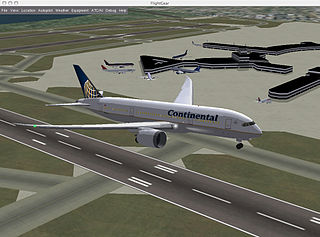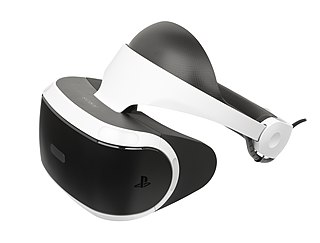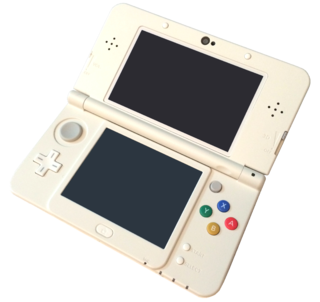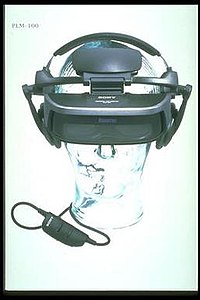
A handheld game console, or simply handheld console, is a small, portable self-contained video game console with a built-in screen, game controls and speakers. Handheld game consoles are smaller than home video game consoles and contain the console, screen, speakers, and controls in one unit, allowing players to carry them and play them at any time or place.

The Sega VR is an unreleased virtual reality headset developed by Sega in the early 1990s. Planned as an add-on peripheral for the Sega Genesis and only publicly showcased at a number of trade shows and expositions, its release was postponed and later cancelled outright after Sega ran into development issues. At least four in-progress games for the hardware were in development before its cancellation.

The history of video games began in the 1950s and 1960s as computer scientists began designing simple games and simulations on minicomputers and mainframes. Spacewar! was developed by Massachusetts Institute of Technology (MIT) student hobbyists in 1962 as one of the first such games on a video display. The first consumer video game hardware was released in the early 1970s. The first home video game console was the Magnavox Odyssey, and the first arcade video games were Computer Space and Pong. After its home console conversions, numerous companies sprang up to capture Pong's success in both the arcade and the home by cloning the game, causing a series of boom and bust cycles due to oversaturation and lack of innovation.

Virtual reality (VR) is a simulated experience that employs 3D near-eye displays and pose tracking to give the user an immersive feel of a virtual world. Applications of virtual reality include entertainment, education and business. VR is one of the key technologies in the reality-virtuality continuum. As such, it is different from other digital visualization solutions, such as augmented virtuality and augmented reality.

Augmented reality (AR) is an interactive experience that combines the real world and computer-generated content. The content can span multiple sensory modalities, including visual, auditory, haptic, somatosensory and olfactory. AR can be defined as a system that incorporates three basic features: a combination of real and virtual worlds, real-time interaction, and accurate 3D registration of virtual and real objects. The overlaid sensory information can be constructive, or destructive. As such, it is one of the key technologies in the reality-virtuality continuum.

A graphics card is a computer expansion card that generates a feed of graphics output to a display device such as a monitor. Graphics cards are sometimes called discrete or dedicated graphics cards to emphasize their distinction to an integrated graphics processor on the motherboard or the central processing unit (CPU). A graphics processing unit (GPU) that performs the necessary computations is the main component in a graphics card, but the acronym "GPU" is sometimes also used to erroneously refer to the graphics card as a whole.
VAIO is a brand of personal computers and consumer electronics, currently developed by Japanese manufacturer VAIO Corporation, headquartered in Azumino, Nagano Prefecture.

A head-mounted display (HMD) is a display device, worn on the head or as part of a helmet, that has a small display optic in front of one or each eye. HMDs have many uses including gaming, aviation, engineering, and medicine.

An electronic game is a game that uses electronics to create an interactive system with which a player can play. Video games are the most common form today, and for this reason the two terms are often used interchangeably. There are other common forms of electronic game including handheld electronic games, standalone systems, and exclusively non-visual products.

An active shutter 3D system is a technique of displaying stereoscopic 3D images. It works by only presenting the image intended for the left eye while blocking the right eye's view, then presenting the right-eye image while blocking the left eye, and repeating this so rapidly that the interruptions do not interfere with the perceived fusion of the two images into a single 3D image.
TDVision Systems, Inc., was a company that designed products and system architectures for stereoscopic video coding, stereoscopic video games, and head mounted displays. The company was founded by Manuel Gutierrez Novelo and Isidoro Pessah in Mexico in 2001 and moved to the United States in 2004.

Future Vision Technologies (FVT), operating from 1991 to 1995, was part of the second wave of companies working to commercialize virtual reality technology. The company was founded by a team out of the Advanced Digital Systems Laboratory in the department of Electrical and Computer Engineering at the University of Illinois at Urbana-Champaign. The three original members, Matt Klapman, David Frerichs, and Kevin Lee, were later joined by John Belmonte. The company ceased to be an active entity when its PC card business was sold to Fujitsu Microelectronics.

A flight simulation video game refers to the simulation of various aspects of flight or the flight environment for purposes other than flight training or aircraft development. A significant community of simulation enthusiasts is supported by several commercial software packages, as well as commercial and homebuilt hardware. Open-source software that is used by the aerospace industry like FlightGear, whose flight dynamics engine (JSBSim) is used in a 2015 NASA benchmark to judge new simulation code to space industry standards, is also available for private use. A popular type of flight simulators video games are combat flight simulators, which simulate combat air operations from the pilot and crew's point of view. Combat flight simulation titles are more numerous than civilian flight simulators due to variety of subject matter available and market demand.

Oculus Rift is a discontinued line of virtual reality headsets developed and manufactured by Oculus VR, a virtual reality company founded by Palmer Luckey that is widely credited with reviving the virtual reality industry. It was the first virtual reality headset to provide a realistic experience at an accessible price, utilizing novel technology to increase quality and reduce cost by orders of magnitude compared to earlier systems. The first headset in the line was the Oculus Rift DK1, released on March 28, 2013. The last was the Oculus Rift S, discontinued in April 2021.
Liquid Image Corporation was a Winnipeg-based company that manufactured head-mounted displays. The company formed in 1992 by Tony Havelka, David Collette and Shannon O'Brien. Liquid Image was started in Winnipeg, MB in response to the emergence of a market for virtual reality technology. Funding as provided by a group of local angels and the first office was in the attic of Tony Havelka.

The PlayStation VR is a virtual reality headset developed by Sony Interactive Entertainment, which was released in October 2016.

A stereoscopic video game is a video game which uses stereoscopic technologies to create depth perception for the player by any form of stereo display. Such games should not be confused with video games that use 3D game graphics on a mono screen, which give the illusion of depth only by monocular cues but lack binocular depth information.

A virtual reality headset is a head-mounted device that provides a virtual reality environment for the wearer. VR headsets are widely used with VR video games but they are also used in other applications, including simulators and trainers. VR headsets typically include a stereoscopic display, stereo sound, and sensors like accelerometers and gyroscopes for tracking the pose of the user's head to match the orientation of the virtual camera with the user's eye positions in the real world.
Visual Cloud is the implementation of visual computing applications that rely on cloud computing architectures, cloud scale processing and storage, and ubiquitous broadband connectivity between connected devices, network edge devices and cloud data centers. It is a model for providing visual computing services to consumers and business users, while allowing service providers to realize the general benefits of cloud computing, such as low cost, elastic scalability, and high availability while providing optimized infrastructure for visual computing application requirements.

A virtual reality game or VR games is a video game played on virtual reality (VR) hardware. Most VR games are based on player immersion, typically through head-mounted display unit or headset with stereoscopic displays and one or more controllers.















